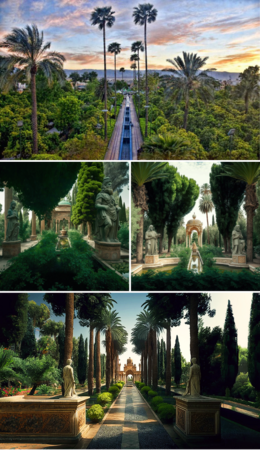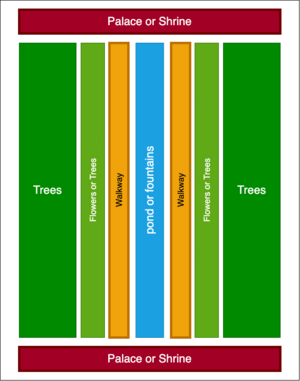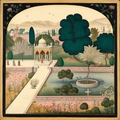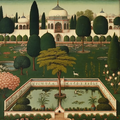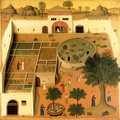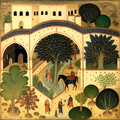Koman gardens
The garden design tradition and style represented by Koman gardens or Asharid gardens (rug), part of a larger Vaniuan tradition of landscaping, has influenced designs in countries initially part of the Great Horde, spreading throughout Vaniua as a standard design for Sayanic gardens. The complexity and depth of the Âruğ stem from its endeavor to represent Zarasaist thought and philosophy into a three-dimensional space, where natural, architectural, and theological elements are arranged in a way that may be interpreted differently depending on the observer. Gardens may be designed to introduce a Sayanic concept, materialize it, or simply adorn a space with specific symbolism. In any case, Asharid gardens and Sayanic gardens as a whole are distinguished by their theological nature instead of merely serving as decorative spaces.
The practice of landscaping and elaborated gardening can be traced back to early Ohanian cultures and the expansion of the Mamikian Empire, with the creation of pantheistic areas designed for specific deities, either functioning as an alternative to early temples or just as a way to express devoutness to a deity, in connection to nature. Early Zarasaism was greatly influenced by late Ohanian cultures, which culminated in the adoption and reinterpretation of many beliefs and traditions, one of these resulting in the practice of Sayanic gardens, with around 2000 years of historical development.
Asharid gardens originated from the usage of Sayanic gardens in Qarashas during the Tamir Khanate, the implementation of such gardens as much more than complementary spaces to palaces and gharams came during the early 12th century with the Tamir Exodus, shortly after the invasions by the Sunrise Horde. Mahavic conquerors settling in eastern Vaniua and later founders of the Qomandi Khanate, White Horde, and Great Horde adopted this practice and helped its spread throughout their sphere of influence. Most prominently, the more cosmopolitan Great Horde expanded on its usage and made it an important component of classical Asharid cities. During their rule, various styles of Asharid gardens developed, examples of Asharid gardens include the Ghizamak garden in Qamaduth, the Gherahan garden and Asavan palace, all located in Shozasan, Balakia, the Meshara garden and Hadjamak's mausoleum in Samadar, Komania, and lastly Nadjakhar's mausoleum in Vaqht, Baghazan.
Concept and etymology
A core concept of Asharid gardens is the use of Euclidean geometry to create regular shapes and patterns within three-dimensional spaces. Circular and rectangular designs are commonly used, with intricate arrangements of plants, ponds, and architectural features conjoined to create symmetry and balance. The use of Euclidean geometry is paired with elements of Parallax to create a play in dimensions and depth.
Proportion is another key element of Koman Gardens. The Golden ratio, a mathematical ratio of approximately 1.618, is often used to create a sense of balance and harmony within the various elements of such spaces. This ratio is used to determine the placement of plants, fountains, and other components within a garden, creating a natural flow that emphasizes the beauty of the space. The use of advanced mathematics and symmetry came hand-in-hand with the belief of mathematics as the 'language of God', allowing designers to apply theories that validate Sayanic theology.
Apart from geometry and mathematics, religious symbols and iconography are a central part of the design of fountains, statues, ponds, and architectural features, reflecting the religious beliefs of a garden. These elements are arranged in a way that reflects specific theological concepts and beliefs, creating a garden that conveyed a deep sense of spiritual depth and significance but also functions as a portrait of ideas and mythology.
History
15th century depiction of the Meshara garden in Samadar, Komania.
16th-century depiction of the Nadjakhar complex in Baghazan.
Elements of the Asharid garden
